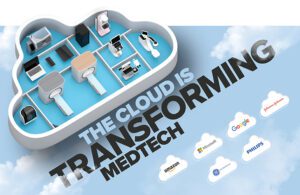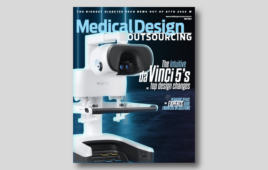
[Illustration via Adobe Stock]
Leaders in medtech and cloud computing discuss payoffs and potential in device connectivity, product development and cross-industry partnerships.
If knowledge is power, that power comes from a steady stream of information, and we know there’s no shortage of that in healthcare.
The challenge has long been how to capture that information, store it, analyze it and deploy it to improve medical product design, manufacturing and the health of patients.
Then came the cloud, and with it a host of acronyms: software as a service (SaaS), platform as a service (PaaS), infrastructure as a service (IaaS), and — following the same convention — software as a medical device (SaMD).
Over the past few months, Medical Design & Outsourcing connected with leaders in medtech and cloud computing, including the three largest providers of cloud computing services: Amazon (Nasdaq: AMZN), Microsoft (Nasdaq: MSFT) and Google (Nasdaq: GOOGL). They offered examples of success stories in the cloud, ways the cloud can lift medicine to new heights, and some advice for medtech insiders looking to harness the power of cloud computing.
The following excerpts have been edited for space and clarity.
MDO: What are some surprising and inspirational examples of what cloud computing enables with regard to medical device design, manufacturing and capabilities/performance?

Alissa Hsu Lynch [Photo courtesy of Google]

David Rhew [Photo courtesy of Microsoft]

Taha Kass-Hout [Photo courtesy of Amazon]

Roshy Francis [Photo courtesy of GE Healthcare]
MDO: What are some previously unthinkable advances that now seem increasingly likely to become reality?

Larry Jones [Photo courtesy of Johnson & Johnson ]

Christine Storm [Photo courtesy of Philips]
Rhew (Microsoft): We know the duration of a surgery has a direct impact on surgical outcomes. We now can get more granular. And that’s what’s exciting because we’re starting to gather patient-specific information but can start also thinking about different devices and different procedures being done within, say, the surgical unit. We can then start pulling all that together and analyzing across the board, comparing hospitals to hospitals and providers to providers. There is so much variation in care, and a lot of times it’s unwarranted, and there are often best practices that can be gleaned. If we can understand what the benchmarks are and strive toward those, we can lead to better quality improvements. And that can only be done when you have data that’s accessible at the granular level, roll it up into different areas, benchmark it and allow for AI to be applied on top of it to provide real-time guidance and support and improve patient outcomes.

Rekha Ranganathan [Photo courtesy of GE Healthcare]
MDO: What sort of big, futuristic dreams do these or other advancements inspire?
Lynch (Google): With the exponential growth of data in healthcare, the future of medtech will be about connected care. And in the future of connected care, technology will be a gateway to healthcare. I think it’s important to say that while AI has the potential to expand access to better care, we need to find ways to ensure equity, access and improved outcomes for everyone. AI technologies should work for the common good. I truly believe that big data and AI can help transform healthcare from reactive care to predictive, personalized and proactive care. But it will take all of us working together across the ecosystem — medtech and Big Tech, governments, health plans, health systems, research institutions and other stakeholders — to make this vision a reality.

Peter Schulam [Photo courtesy of Johnson & Johnson ]
Kass-Hout (AWS): Equity in care. How are we able to take all this information to provide more equitable care? Healthcare is a $7.5 trillion business globally, yet more than 4 billion people don’t have access to care — forget about high-quality care, just access to care in general. I believe AI and technology have to be part of a solution to creating that more equitable access. The future of healthcare is so vibrant and dynamic right now. It’s so dependent on big data, on AI and on cloud computing. Promising innovations like precision medicine, conversational chatbots, intelligent scribes, and APIs for data and interoperability may make healthcare better and more efficient and more equitable in the future.
MDO: What does cloud computing mean for how medical device designers and engineers should be thinking?
Schulam (Johnson & Johnson): When you’re looking at a medical device in the conventional manner, you spend a long time developing, you launch, and then you never iterate. Guess what? In the software world and the agile world, it’s exactly the opposite: a minimal viable product and multiple iterations. We have to create this hybrid innovation cycle.
Jones (Johnson & Johnson): It means designing connectivity in your solution. Design with security in mind as part of the product offering. Be very proactive in what sensors you’re using, what are you designing, even to the point of what preventive maintenance looks like. Learning from Microsoft, as we’re designing products, don’t try to solve problems that have already been solved. There’s a lot of leverage across the board, and that’s why we’re we believe this audacious task is gonna take partnerships to do that. I remember when we had constraints on any product design. Storage was expensive. Computing was expensive. Battery life was challenging. Things like connectivity and speed, with 5G, 6G forthcoming with the cloud and being able to amass unlimited storage at a fraction of a cost, those constraints in your design aren’t as plentiful as they were in the past. I’m not a mechanical engineer, but I do believe that you’re now building without constraint.
Read more from our conversations with these leaders and more at Johnson & Johnson, Microsoft, Philips, Google, GE Healthcare, Delta Development and Amazon Web Services.
View this story as it appeared in the May 2022 print edition of Medical Design & Outsourcing.




![A photo of the Medtronic GI Genius ColonPro polyp detection system flagging a potential sign of colon cancer during a colonoscopy. [Photo courtesy of Medtronic]](https://www.medicaldesignandoutsourcing.com/wp-content/uploads/2024/04/Medtronic-GI-Genius-doctors-268x170.jpg)